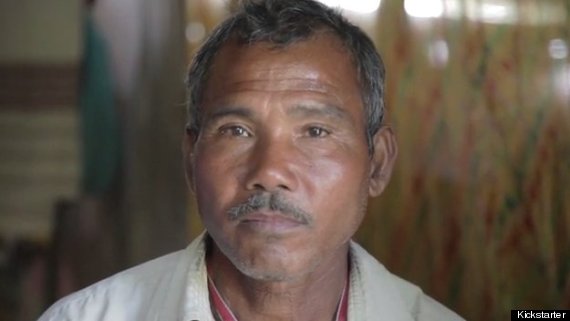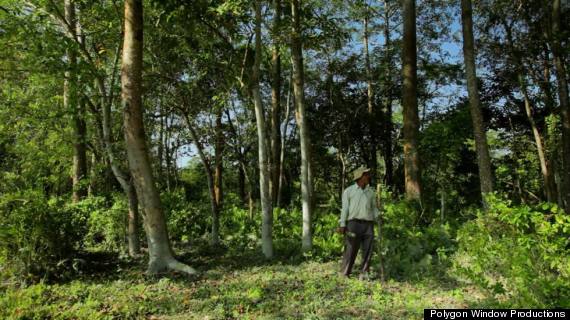One Man Single-Handedly Plants Forest Bigger Than Central Park
He did it to save his home.
In the middle of a braided river tucked in a remote northeastern region of India, one man planted a forest that has now outgrown the size of New York City’s Central Park.
As a teenager in the 1970s, Jadav Payeng noticed a rush of snakes washing ashore, dead. Erosion had scrubbed away vegetation from Majuli island sandbars, stripping away grassy cover and ultimately forcing many native species to flee.
Floodwaters transformed some parts into barren landscapes. Its shorelines receded with every monsoon rain. The island, Payeng’s birthplace, was rapidly shrinking.
Home to approximately 170,000 people, Majuli is one of the world’s largest river islands situated in the middle of the mighty Brahmaputra, making it vulnerable to the tides of a large number of tributaries. The river’s strength reaches an apex every spring when glacial melt from the Himalayas supercharges floodwaters. Flooding has become a problem intensified in recent years due to the effects of climate change and earthquakes, leaving the river's shape and flow altered after seismic activity.
Over the past 100 years, Majuli has lost over 70 per cent of its landmass.
Dr. Arup Kumar Sarma of the Indian Institute of Technology Guwahati explains Majuli Island's erosion problem.
“My house fell into the water,” Runa Buhyan, an elderly farmer, told the New York Times in 2012. “ We are worried about our livelihoods. How can we provide for our families? That uncertainty is always there.”
Rather than sitting idly by, waiting for strong river waters to destroy his home and push his family inland, Payeng planted trees.
He started in 1979, scattering seeds and stabbing the bare earth repeatedly with a stick to forge holes deep enough for the delicate roots of young saplings. The goal was to grow a forest to stave off erosion in the area.
But as his trees grew bigger, Payeng says it dawned on him they were going to be increasingly difficult to protect.
“The biggest threat was from men. They would have destroyed the forest for economic gain and the animals would be vulnerable again," he said in a documentary about his forest.
He quietly continued planting trees on Majuli for 30 years until he was discovered by nature photographer Jitu Kalita in 2009.

Jadav Payeng has been planting trees on Majuli since 1979. Production still courtesy of Will McMaster.
“I was exploring a barren part of the Brahmaputra by boat when I saw something strange: it looked like a forest far in the distance … I couldn’t believe my eyes,” said Kalita.
When he emerged from the forest, he spotted Payeng and followed him to a riverbank. After a tense introduction, the two hit it off. Inspired by the new friendship, Kalita wrote an article about the forest in a local Jorhat newspaper, which catalyzed a “turning point” in Payeng’s life.
In 2012, Canadian filmmaker William Douglas McMaster was on Reddit when he came across an article about the "Forest Man of India." Entranced by his story, McMaster made his way through blogs in hopes of contacting Payeng to make a film about him. One day, someone reached out to the filmmaker claiming to know Payeng. Without an alternative connection, McMaster placed all his trust in the stranger.
"I didn’t meet him until I went to India and was taken to [Payeng], and thankfully that person I trusted was telling the truth," McMaster said in an email to The Huffington Post Canada.
Timing was an issue for McMaster. If he wanted to get the ball rolling on his project, he had to get money — fast. And one way to do that was through crowdfunding campaigns.
“If we had tried to go through the traditional route of funding a film, it would have taken months. Crowdfunding allowed us to get to Payeng’s forest before anyone else,” he said. “We beat National Geographic and the BBC to the punch.”

Payeng stands in his forest he single-handedly planted in Majuli. Production still courtesy of Will McMaster.
McMaster and his small team arrived in India’s Assam region in late 2012 and stayed for about a month. They followed Payeng, documented his routine, and ruminated on his concept of the nature of happiness.
“He taught me that you can accomplish a lot with very little,” McMaster said, “He doesn't even wear shoes. His way of life is extremely pure; free of possessions, yet he is extremely happy and positive.”
McMaster collected his footage and made an 18-minute short film in 2013 titled “Forest Man.” This summer, it won best documentary at The American Pavillion Emerging Filmmaker Showcase at Cannes.
“We hear stories all the time about environmental destruction, and we’re numb to it. Millions of acres of destroyed rainforest is nearly impossible for a person to imagine,” said the Toronto-based filmmaker.
To McMaster, “Forest Man” stands out because it counters a cataclysmic narrative commonly linked to stories of climate change. Today, Payeng’s forest measures 1,400 acres, a remarkable accomplishment that dwarfs Central Park’s 843 acres. Rhinoceroses, deer, tigers, and as many as 115 elephants have moved in to the dense forest. Vultures have also returned to the area for the first time in 40 years.
“What Payeng has done is to show that a single person can make a measurable, positive impact on the environment,” said McMaster
“I think that message is more powerful than simply showing people all that we’ve done wrong, with no way to make it better.”
This article is syndicated from HuffPost . Huffpost,(formerly The Huffington Post) is an American news and opinion site that has both localized and international editions. The site offers news, satire, blogs, and original content and covers politics, business, entertainment, environment, technology, popular media, lifestyle, culture, comedy, healthy living, women's interests, and local news. Author Zi-Ann Lum writes for The Huffington Post Canada


On Jul 31, 2017 M.K.Ward wrote:
WeTrees, created by Bill Laio, has planted one billion trees, while providing a positive work option for women in 3rd world countries....he is a serial philanthropist - also check out his RebelBio
Post Your Reply